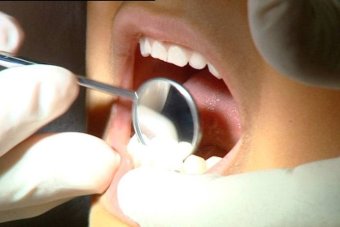The level of tooth decay in people living in some remote areas of Australia is worse than that of their city peers, the Royal Flying Doctor Service (RFDS) says.
A new RFDS report shows cavities in country children are 55 per cent higher than city children and almost 40 per cent of adults in the bush suffer the chronic disease of untreated tooth decay, compared to less than a quarter in the city.
The rate is worse for Indigenous Australians, with 57 per cent also suffering tooth decay.
RFDS CEO Martin Laverty said there was a lack of dentists in regional and remote areas.
“There are three times more dentists in the city than there are in the bush, and it’s because country kids are not able to get access to dental services that we are seeing high tooth decay in country areas,” he said.
Tooth extractions, missing teeth and gum disease in both children and adults were also found to be far higher in country areas.
Mr Laverty said the findings reflected wider health concerns for those living remotely.
There must be access to good healthy food and clean water. I see a lot of kids in the bush, they have access to sugar more easily than they have access to clean water.
Dr Jijesh Nhalila Valappil, dentist
“Children that have greater cavities have an impact in their ability to learn and ability to grow up strong and healthy. Poor oral health plays a role in cardiovascular and kidney disease.”
Mr Laverty said it was not reasonable to expect dentists in every country town, so has instead called for a nation-wide rollout of its flying dentist program as the primary solution.
The program has already been introduced in parts of South Australia, NSW and Queensland, but the RFDS said it needed federal money to ensure every corner of Australia was covered by fly-in or drive-in dentists.
“We’ve said to the Federal Government, having provided dental care to 11,500 people in the last year through our fly-in and drive-in services, we want to see that expanded,” Mr Laverty said.
“It’s the Australian Government through the Australian constitution that is responsible for funding dental services.”
Dentists say relocation more effective
But other parts of the dental industry said the money could be spent elsewhere.
Dr Jijesh Nhalila Valappil set up a practice in Nhulunbuy about two years ago with help from the Federal Government’s rural health workforce dental relocation support scheme.
“They provide up to [about] $200,000 … for new equipment and refurbishing your surgery, because a dental surgery is quite expensive to set up,” he said.
Dr Valappil said relocation was more effective.
“If a dentist is actually in the town, and spending more time in town, they also get the opportunity to promote health as well, rather than just treating decay or disease.”
Australian Dental Association NT branch head Steven Burlinson made a similar point.

“The key to FIFO services is having continuity of practitioners to provide the services so that the community get to know the dentist and the dentist gets to know the patients,” Mr Burlinson said.
“It helps to build trust with the community and of course being seen by the same dentist means that progress or deterioration in a person’s oral health can be monitored more closely.”
But Professor Marc Tennant from Oral Health and Equity supported the RFDS’s argument and said it was not always viable to relocate dentists.
“In many larger places, the idea of supporting a dentist to live and work there … is a good answer,” Professor Tennant said.
“But in some of the more remote areas, particularly in the Northern Territory, the idea of visiting services is a really important way to answer that question.”
The Territory already has a publically funded fly-in dental scheme run by Oral Health NT, which already services 73 remote communities; the larger ones such as Maningrida and Wadeye have dentists one week per month.
Oral Health NT declined to comment on this story.
“I think the NT Government is correct, they do many services like that,” Professor Tennant said.
“That’s not saying there isn’t a place for the RFDS to assist in that network of care.”
Water fluoridation, better diet key to reducing decay rates: dentist
The dental industry does agree that better preventative measures would help reduce the high levels of teeth decay and cavities in both children and adults in the bush.
Getting fluoride into the water supply in every town or remote community has long been a priority. In the Territory, it’s limited to regional hubs.
“In the communities outside of Gove, the kids don’t have access to fluoride,” Dr Valappil said.
“And if you don’t use toothpaste, there’s no access to fluoride.”
The RFDS report also identified major contributing factors including poor diet, a lack of access to healthy food, abuse of alcohol and tobacco, a lack of education and poor access to dental hygiene products.
“At the moment there are places where good food is extremely expensive. It has problems for dentistry and for general health as well,” Professor Tennant said.
“We will find from addressing those grand health problems, that dental health will improve at the same time.”
“There must be access to good healthy food and clean water. I see a lot of kids in the bush, they have access to sugar more easily than they have access to clean water,” Dr Valappil said.
“That’s one that needs to be looked into.”

